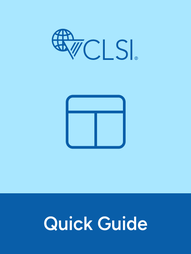CLSI C56QG
Examples of Hemolyzed, Icteric, and Lipemic/Turbid Samples Quick Guide
This Quick Guide shows examples of hemolyzed, icteric, and lipemic/turbid samples. Formatted as a durable, waterproof sheet for quick reference.
{{FormatPrice(currentPrice)}}
Free
{{FormatPrice(nonMemberPrice)}} List PriceClinical and Laboratory Standards Institute document C56-A—Hemolysis, Icterus, and Lipemia/Turbidity Indices as Indicators of Interference in Clinical Laboratory Analysis; Approved Guideline focuses on the intended usefulness and challenging issues of hemolysis, icterus, and lipemia/turbidity (HIL) indices as estimates of interference that may impact the validity and clinical utility of reportable patient results. C56 is closely aligned with CLSI document EP07; thus, the basic concepts for interference testing are briefly discussed in C56 to gain an understanding of the process by which HIL alert indices are established. Automated HIL systems currently available from various manufacturers are also described. This document enhances the continuous education of health care personnel by explaining the mechanisms of HIL interference, which in some cases include the noncorrelation of visual and (semi)quantitative HIL indices, the strengths and limitations of HIL measurements, and the verification of HIL indices in the clinical laboratory.
This archived document is no longer being reviewed through the CLSI Consensus Document Development Process. However, this document is technically valid and because of its value to the laboratory community, it is being retained in CLSI’s library.
This document is available in electronic format only.
Clinical and Laboratory Standards Institute document C56-A—Hemolysis, Icterus, and Lipemia/Turbidity Indices as Indicators of Interference in Clinical Laboratory Analysis; Approved Guideline focuses on the intended usefulness and challenging issues of hemolysis, icterus, and lipemia/turbidity (HIL) indices as estimates of interference that may impact the validity and clinical utility of reportable patient results. C56 is closely aligned with CLSI document EP07; thus, the basic concepts for interference testing are briefly discussed in C56 to gain an understanding of the process by which HIL alert indices are established. Automated HIL systems currently available from various manufacturers are also described. This document enhances the continuous education of health care personnel by explaining the mechanisms of HIL interference, which in some cases include the noncorrelation of visual and (semi)quantitative HIL indices, the strengths and limitations of HIL measurements, and the verification of HIL indices in the clinical laboratory.
This archived document is no longer being reviewed through the CLSI Consensus Document Development Process. However, this document is technically valid and because of its value to the laboratory community, it is being retained in CLSI’s library.
This document is available in electronic format only.
